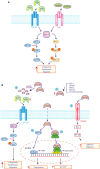Prognostic and Therapeutic Roles of the Insulin Growth Factor System in Glioblastoma
- PMID: 33604294
- PMCID: PMC7885861
- DOI: 10.3389/fonc.2020.612385
Prognostic and Therapeutic Roles of the Insulin Growth Factor System in Glioblastoma
Abstract
Glioblastoma multiforme (GBM) is the most common primary brain malignancy and is often resistant to conventional treatments due to its extensive cellular heterogeneity. Thus, the overall survival of GBM patients remains extremely poor. Insulin-like growth factor (IGF) signaling entails a complex system that is a key regulator of cell transformation, growth and cell-cycle progression. Hence, its deregulation is frequently involved in the development of several cancers, including brain malignancies. In GBM, differential expression of several IGF system components and alterations of this signaling axis are linked to significantly worse prognosis and reduced responsiveness to temozolomide, the most commonly used pharmacological agent for the treatment of the disease. In the present review we summarize the biological role of the IGF system in the pathogenesis of GBM and comprehensively discuss its clinical significance and contribution to the development of resistance to standard chemotherapy and experimental treatments.
Keywords: IGF-binding protein; drug resistance; glioblastoma; insulin-like growth factor signaling pathway; insulin/insulin-like growth factor system.
Copyright © 2021 Tirrò, Massimino, Romano, Martorana, Pennisi, Stella, Pavone, Di Gregorio, Puma, Tomarchio, Vitale, Manzella and Vigneri.
Conflict of interest statement
The authors declare that the research was conducted in the absence of any commercial or financial relationships that could be construed as a potential conflict of interest.
Figures


Similar articles
-
Imp2 regulates GBM progression by activating IGF2/PI3K/Akt pathway.Cancer Biol Ther. 2015;16(4):623-33. doi: 10.1080/15384047.2015.1019185. Epub 2015 Feb 26. Cancer Biol Ther. 2015. PMID: 25719943 Free PMC article.
-
MiR-21: A key player in glioblastoma pathogenesis.J Cell Biochem. 2018 Feb;119(2):1285-1290. doi: 10.1002/jcb.26300. Epub 2017 Aug 28. J Cell Biochem. 2018. PMID: 28727188 Review.
-
Roles of insulin-like growth factor binding protein-2 (IGFBP-2) in glioblastoma.Anticancer Res. 2007 Nov-Dec;27(6A):3685-92. Anticancer Res. 2007. PMID: 17970029 Review.
-
Essential role of Gli proteins in glioblastoma multiforme.Curr Protein Pept Sci. 2013 Mar;14(2):133-40. doi: 10.2174/1389203711314020005. Curr Protein Pept Sci. 2013. PMID: 23544423 Review.
-
Analysis of the cancer genome atlas (TCGA) database identifies an inverse relationship between interleukin-13 receptor α1 and α2 gene expression and poor prognosis and drug resistance in subjects with glioblastoma multiforme.J Neurooncol. 2018 Feb;136(3):463-474. doi: 10.1007/s11060-017-2680-9. Epub 2017 Nov 22. J Neurooncol. 2018. PMID: 29168083 Free PMC article.
Cited by
-
Mechanistic Translation of Melanoma Genetic Landscape in Enriched Pathways and Oncogenic Protein-Protein Interactions.Cancer Genomics Proteomics. 2022 May-Jun;19(3):350-361. doi: 10.21873/cgp.20325. Cancer Genomics Proteomics. 2022. PMID: 35430568 Free PMC article.
-
Investigational treatment strategies in glioblastoma: progress made and barriers to success.Expert Opin Investig Drugs. 2023 Jul-Dec;32(10):921-930. doi: 10.1080/13543784.2023.2267982. Epub 2023 Nov 6. Expert Opin Investig Drugs. 2023. PMID: 37796104 Free PMC article. Review.
-
Nanoparticle encapsulation enables systemic IGF-Trap delivery to inhibit intracerebral glioma growth.Neuro Oncol. 2025 Jun 21;27(5):1227-1240. doi: 10.1093/neuonc/noaf011. Neuro Oncol. 2025. PMID: 39879581 Free PMC article.
-
Glioblastoma, IDH-Wild Type With FGFR3-TACC3 Fusion: When Morphology May Reliably Predict the Molecular Profile of a Tumor. A Case Report and Literature Review.Front Neurol. 2022 Feb 9;13:823015. doi: 10.3389/fneur.2022.823015. eCollection 2022. Front Neurol. 2022. PMID: 35222252 Free PMC article. Review.
-
Associations in cell type-specific hydroxymethylation and transcriptional alterations of pediatric central nervous system tumors.Nat Commun. 2024 Apr 30;15(1):3635. doi: 10.1038/s41467-024-47943-9. Nat Commun. 2024. PMID: 38688903 Free PMC article.
References
Publication types
LinkOut - more resources
Full Text Sources
Other Literature Sources

